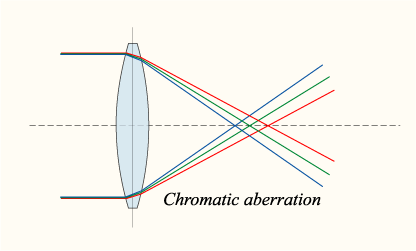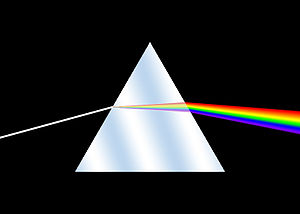AY Honors/Optics/Answer Key
1. Define and/or draw a diagram of the following:
a. Focal length
The distance from the lens (center of lens) or mirror to the focal point.
b. Positive lens
This type of lens creates a real image by converging the rays of light to a common focus.
c. Negative lens
This type of lens diverges the light or causes it to spread. It creates a virtual focal point that appears to be the location where the light is coming from.
d. Two kinds of distortion
- Barrel Distortion
- The Magnification decreases as you get farther from the center of the lens. This is the type of distortion in fisheye lens. It appears like the image has been mapped around a sphere.
- Pincushion Distortion
- The Magnification increases as you get farther from the center of the lens. This is the type of distortion is often seen in low quality telephoto lenses. It appears like the image has been pinched toward the middle.
e. Longitudinal color
Different colors of light are bent to varying degrees as they go though a medium such as glass. This effect is is called Chromatic Aberration. The affect is a longitudinal displacement (along the axis of the lens) of the focus.
Chromatic aberration is caused by the fact that different colors of light travel at different speeds through a medium such as glass. The amount of bend in the light as it travels from one medium to another is given by Snell's law:
- [math]\displaystyle{ \frac{\sin\theta_1}{\sin\theta_2} = \frac{velocity\ 1}{velocity\ 2} = \frac{n_2}{n_1} }[/math]
The bigger the difference in the velocities, the more bending takes place.
f. Lateral color
g. Spherical aberration
Lenses with surfaces that are spherically shaped are easier to manufacture, but they have a flaw that the light that travels through the lens near the center focuses at a different point than the light that travels through the lens near the edge.
Spherical mirrors will show the same aberration as spherical lenses, but it is fairly easy to parabolize a mirror and cause the focus to be at a single point. Non spherical lenses are difficult to manufacture, but modern computer controlled polishing machines are improving lens quality.
h. Achromatic lens
By using two lenses made of different materials we can minimize the amount of chromatic aberration that a lens creates. This principle is used in all high quality lenses to create a better image.
i. Refraction of light
Light is bent as it goes from one medium to another. The more difference there is in the two media, the greater the amount of refraction.
2. Explain how light behaves when it strikes or traverses water, oil, feldspar, and a mirror.
3. Name and draw diagrams of three kinds of positive lenses and three kinds of negative lenses.
4. What should be the minimum distance of light source from the lens when testing for focal length?
5. Find the focal length of at least four lenses, one being a negative lens.
6. Explain by diagram why an image from a positive lens makes an image reversed and inverted.
By drawing lines representing the rays of light, we can show that the light creates an inverted image.
7. Show with diagrams how a prism works. State the angles at which the colors appear and disappear.
A prism uses the fact that different colors of light are bent differently as they travel through a medium. This effect is also seen in chromatic aberration.
The shape of a prism is an equilateral triangle. This causes the colors of light to disperse in a very predictable way.
8. Show and demonstrate what happens when light strikes one-way glass.
9. Construct one optical instrument using mirrors or lenses, such as a periscope, a slide or opaque projector, or a simple telescope.
| Optical Instrument | Design |
| Periscope | 250px |
| Slide Projector | |
| Opaque Projector | |
| Refracting Telescope | |
| Reflecting Telescope |
10. Explain what is meant by the term 6x35 and 7x50 as applied to binoculars.
The numbers used for describing binoculars give the power followed by the diameter of the objective lens (The largest diameter lens) in millimeters. This means that 6x35 have a magnifying power of 6x and have a diameter of 35mm.
The power represents how much bigger an object appears than with the unaided eye. You can also think of how many times closer it appears to be. The diameter lets you know how much light is gathered by the lens. A 50mm objective lens gathers much more light than a 35mm objective lens. Because the amount of light that is gathered increases if we increase the area that the light hits, we can calculate the light gathering of a lens using the area of a circle:
Area of lens= π (radius of lens)[math]\displaystyle{ ^2 }[/math]
| Binocular Specification | Magnifying Power | Diameter of objective (mm) | Area of objective [math]\displaystyle{ mm^2 }[/math] | Light gathering power (compared to unaided eye) |
| Unaided Eye | 1x | 8 | 50.265 | 1x |
| 10x25 | 10x | 25 | 490.8738 | 9.7x |
| 6x35 | 6x | 35 | 962.11275 | 19.14x |
| 7x50 | 7x | 50 | 1,963.495 | 39.06x |
The 50mm objective lens collects 2.0408... times more light than a 35mm objective lens. If you are in a dark environment, you will get twice as much light with the 7x50 binoculars than with a 6x35. The 7x50 binoculars has more magnifying power (7/6 or 1.167 times) than the 6x35 binoculars.
The higher the first number, the larger things appear, but the harder it is to hold the binoculars steady. Above 10x most people need a tripod to hold it steady enough to be useful. The higher the second number, the more light gathering power, which allows you to continue to see even in low light conditions, but the binoculars are much heavier as well.
Knowing what the numbers on a pair of binoculars mean is important as you are choosing which ones are best for you, but binoculars are a very personal thing, so try them before you buy them.
11. Define the term "f/stop" as used in connection with cameras. What does it mean when a lens is fast or slow? Is an f/8.5 lens faster or slower than an f/8 lens?
A faster lens has a lower f-number, and lets in more light than a slower lens. The f-number is the ratio of the diameter of the entrance pupil to the focal length of the lens.
[math]\displaystyle{ f\ number = \frac {Focal\ length} {Diameter\ of\ objective} }[/math]
The two parameters that define the f-number of an optical system are:
- Focal Length
- The longer the focal length, the more magnifying power the optical system has. You will choose a very long focal length lens if you wish to photograph birds, and a short focal length lens to photograph scenic shots such as a panarama.
- Diameter of the lens
- The larger the diameter the more light is let in. So to have a fast lens, you will need a large diameter lens, and the longer the focal length, the larger the diameter needs to be to have the same speed. A 50mm f/4 lens will have a diameter of 12.5 mm, but a 400mm f/4 lens will have a diameter of 100mm.
The advantage of a faster lens is that there is more light, so it is easier to see, and for photography, you can keep the exposure time low.
The disadvantage of a fast lens is that it is heavier, and has less depth of field.
References
About the Author
--Rodneyeast 14:06, 23 October 2006 (UTC)
Rodney East works with a Pathfinder Club in Glenn Ellyn Illinois, and has been involved with Pathfinder from the age of 9 when his grandmother introduced him to the stars by working on the Star honor.
He studied everything he could find on astronomy as he was growing up and finally graduated from Pacific Union College with a Bachelors degree in Physics with an emphasis in Astronomy.
He now works in the Information Technology group of the Advanced Photon Source at Argonne National Laboratory.
Rodney and Stephanie East Produced the DVD entitled "Why Knot, an introduction to knots, rope, and splices" to help teach the Knot Tying Honor. This video is available through Advent Source.











